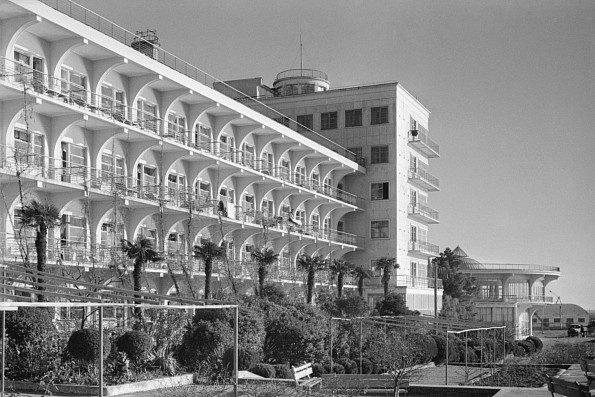Anthology of resort architecture
State Museum of Architecture named after A.V. Shchusev, with the support of the Sochi City Administration, presents an exhibition project dedicated to the architectural heritage of the resort city, “An Anthology of Resort Architecture. Sochi - Matsesta. XX century. The exhibition will be held within the walls of the Sochi Art Museum named after D.D. Zhilinsky.
The exhibition is a "guidebook", offering the viewer to plunge into the world of images of architecture of the XX century. "Anthology" (ἀνθολογία) is a term originally applied to a collection of literary texts and subsequently extended to other art forms. “Anthology” is translated from Greek as “a collection of flowers”, and if we imagine the biosphere of the Sochi region as a garden, then the buildings shown at the exhibition can be safely called a bouquet of flowers, carefully planted by the genius of an architect-gardener. Such a metaphorical approach makes it possible to look at Sochi not through the eyes of a consumer of sanatorium services, but by a researcher who studies the city as an open-air museum of architecture. Viewers of the exhibition will have the opportunity to look at the buildings, closed from strangers by high fences, which are in ruins, lost.
The modern history of Sochi begins in the early Soviet period, when on May 25, 1925 the settlement received the status of a resort city. A distinctive feature of the Sochi-Matsesta region is that here the Soviet authorities could build an ideal resort from scratch, ignoring the legacy of the tsarist period, as was the case in Mineralnye Vody or the Crimea. If at the beginning of the 20th century there were 60 sanatoriums throughout Russia, then by the end of the 1930s, in the Sochi-Matsesta region alone, there were already 75 sanatoriums and rest houses.
The exhibition will feature more than 80 items, including graphic projects of buildings and photographs of resort architecture by such significant photo artists as S.O. Friedland, Ya.N. Khalip, A.A. Aleksandrov, M.M. Churakov, I.M. Churakov. The theme of the exhibition reveals the history of the formation of the image of the city of Sochi in three chapters:
The first section - "To be a resort!" - talks about the beginning of the development of Sochi in the era of architectural avant-garde and innovations in southern architecture, demonstrates graphic works and photographs of A.A. Vesnina, L.A. Vesnina, A.V. Shchuseva, M.I. Merzhanova. The presented projects reflect the courage and innovation of the representatives of the young Soviet avant-garde in search of new forms: free planning of the building, strip glazing, deep loggias, flat roofs with a solarium.
The second hall - "Socialist Utopia" - presents photographs of buildings of the 1930-80s, when the classical tradition with an abundance of decor and lavish furnishings and ascetic innovative architecture, aimed at combating "excesses", alternately became a guide for architects. At the next round of development, the aesthetics of glass and concrete replaced the order. The democratization of public space and the development of domestic tourism have attracted new vacationers to the Black Sea coast.
The third chapter - "City of Dreams"- dedicated to the public architecture of the central district of Sochi, the formation of the image of the city, carefully thought out by the architect Nazim Nesis, as well as the formation of the city's transport infrastructure and leisure centers, cafes. The exhibition space is formed on the contrast of two "super styles" - classical and modernist, which create the appearance of public buildings.
Over the years, the most talented architects of the generation were invited to design buildings in Sochi: Alexei Shchusev, Alexander and Leonid Vesnin, Miron Merzhanov, Karo Alabyan, Ivan Zholtovsky, Alexei Dushkin, Igor Vinogradsky, Ivan Kuznetsov, Nikolai Kolli, Vyacheslav Morozov, Evgeny Serdyukov, Victor Schulrichter. The buildings of the past century are fading into the shadow of modern construction, but they are examples of high art, and still remain architectural constants that determined the urban appearance of Sochi. Preservation, restoration, functioning of monuments of Soviet architecture is an integral part of the cultural continuity of the resort in the preservation of identity.
